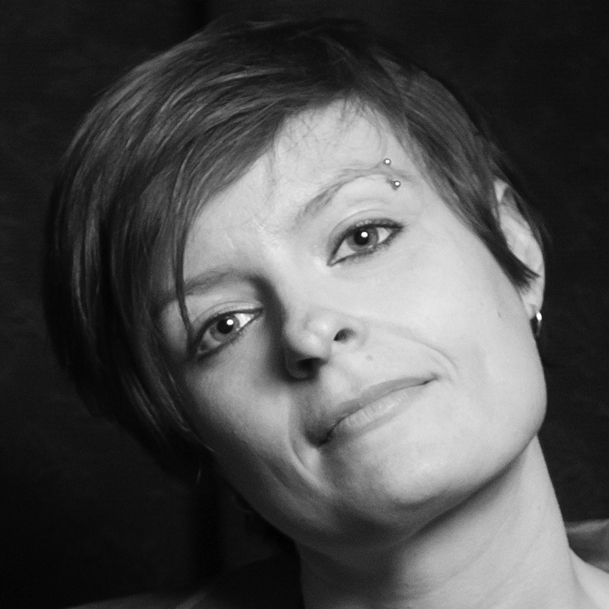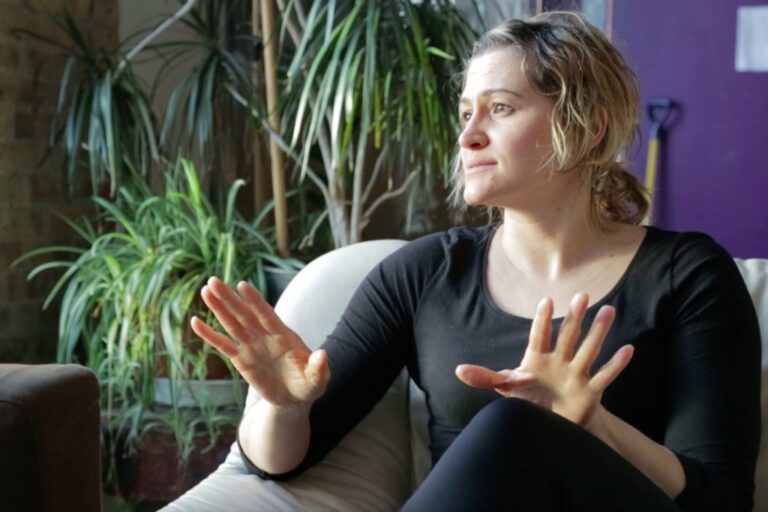A Crack in Everything
The Crackwalker is one of the most iconic plays in Canadian history. Thirty-five years after its debut, Intermission’s editors, Maija Kappler and May Antaki, sat down with playwright Judith Thompson and actors Joanna McIntyre, Lynne Deragon, and Hardee T. Lineham, for a conversation about what was going through their minds during those first few productions.
It’s one of the coldest days of the year, we’re waiting to meet four people who haven’t been in the same room together for over thirty years, and we just realized we don’t have any snacks.
Setting up this reunion was a complicated process. Our idea for a roundtable with the original five-person cast of The Crackwalker was approved by Judith Thompson, the show’s playwright, who’s directing a new production of the show on now at Factory Theatre. But given that over thirty-five years have passed since The Crackwalker opened, she no longer had a way to reach any of the actors. So we scrounged, and we had a few lucky breaks: our publisher, Phil, knew Hardee T. Lineham, and Geza Kovacs responded to the email we sent his agent. But Jane Foster and Joanna McIntyre had both stopped acting. Jane, with an all-too-common name, had no internet-accessible contact information we could trace back to her, and while there were several sources that mentioned a Jo Ann/JoAnn/Joann/Joanna McIntyre, it took five attempts to reach the right one. And Graham Greene was busy, shooting a movie in the States. So we moved on to the play’s second production in Montreal, where Lynne Deragon and Frank Moore took over the Sandy and Joe roles. Lynne signed on enthusiastically. So we had three of the central characters from the original cast and one from the second production, plus the playwright. Not too bad.
We still weren’t sure how it would all go. We had vague ideas that there might have been some turmoil at the time of the production. We were worried that not everyone would want to talk openly about that experience, that they might not remember many stories, or they might get lost en route to our third-floor office in what’s not the world’s most intuitively laid-out building. And now, they might also be hungry.
But once we’re all in the same room, after running to the café across the street for some last-minute banana bread, the prevailing feeling is a surprising sense of comfort. Judith, Joanna, Lynne, and Hardee greet each other with real warmth. (The news that Geza had agreed to come but had to pull out at the last minute doesn’t surprise anyone—they affectionately remember him sleeping through the occasional rehearsal.) But everyone else is here, and they’re all excited to talk about the play.
“I don’t want to hyperbolize this, but…”
In the hour and a half that the six of us spend around the table, this is a line that Hardee, who played Alan, repeats several times in different variations. The Crackwalker is a play that’s difficult to talk about in terms that are not superlatives; it has been called “theatre that takes you to the edge of hell” and “maybe the most powerful play ever written in Canada.” It’s routinely taught in theatre schools and drama courses across the country, and is an undeniable fixture in the Canadian theatre canon. One example of its power is the prevalence its unorthodox language and lengthy, illuminating monologues have in contemporary auditions. One scene in particular, where the turbulent Alan meditates on the intrusive nature of “ugly thoughts”—specifically, the tale of a medical anomaly where a woman had a cauliflower-like genital growth—is a favourite of many auditioning actors. Judith says she’s seen audition spaces specifically ask actors to avoid this monologue, and as someone who runs auditions herself, she can understand why. “If I hear that cauliflower monologue one more time…”

The Crackwalker takes ideas that are usually ignored or suppressed and puts them centre stage, on full display, loud and bloody and frothing at the mouth. Judith Thompson wrote the play while she was in her twenties, inspired by a co-worker she had while working as a waitress and by clients assigned to her when she was a social worker. The play tells the story of two doomed couples. Theresa, an occasional sex worker with developmental problems, is worshipped by her devoted boyfriend, Alan, until he commits a brutal act of violence that upends both of their lives. Theresa’s best friend, Sandy, is stuck in a destructive stalemate with her abusive husband, Joe. The four of them fight and hurt and commiserate with each other, occasionally interacting with the titular Crackwalker, a figure who sees and magnifies their misery. The characters’ interactions are often grim, but the ugliness in the play is offset with a surprising amount of humour. The word choices—derisively referred to by one critic as “gutter language,” Judith says—are simple and direct, colloquial, almost always graphic. But there’s a certain lyricism to the dialogue, especially those monologues. It’s a play without a precedent.
This is all very clear now. But when The Crackwalker opened at Theatre Passe Muraille’s backspace on November 26, 1980, its reception was a bit different. It was a small and unusual production, with a young cast and crew, and those circumstances didn’t lead to immediate accolades. Judith remembers trying to usher people in off the streets just to fill space in the theatre. Hardee recalls that “there wasn’t much attention paid” to the show.
“There was one terrible review,” Judith inputs.
“Oh yeah, that’s right!” says Joanna, who played Theresa.
“There was one terrible review,” Hardee, acknowledges, “by the Star critic—”
“Well then, there were two terrible reviews!” Judith is quick to point out. The one she was thinking of appeared in The Globe and Mail.

The difficulty of The Crackwalker’s subject matter and the intensity of the characters’ relationships led to both a tension and an intimacy between the people who spent their days immersed in these fictional lives. Harsh words were exchanged about characters’ motivations, about how the dialogue should be delivered. There was pressure to be accurate, to correctly and respectfully act out experiences not often seen onstage. “We were all young and idealistic and it had to be perfect,” Joanna remembers.
Tensions ran high between Judith and the director, the late Clarke Rogers, often over conflicting interpretations. “We fought all the time because he was often wrong, frankly,” she says. “I had to fight him on things, and be a pain in the ass.” Once he barred her from set because she laughed when a joke in the script played out successfully onstage, but immediately called her back to beg for her help with another scene. It took three days of cajoling before she was willing to return. The anxiety was acute; she remembers developing sties and acne cysts from the stress, constant physical reminders of the strain caused by the show. “It was almost not worth it, but it was.”
Hardee thinks the viciousness of these arguments came from the ensemble’s shared investment in work they knew was challenging and important—in his words, “the passion of the project.” He likens the arguments to “having a fight with your lover”; a raw, intimate kind of conflict ignited by fire. That intimacy came from the strength of the text, but it was also borne of circumstance: their (shared) dressing room was “basically a hole,” according to Joanna. “There was a drain in the middle of the room. You’d walk in and mice would be running around on the floor.” Sharing this kind of a space felt like sharing a cell; it was grimy and foul but being there together bonded them.

It wasn’t just the reviewers who objected to The Crackwalker’s language, or its characters, or its focus on violence and madness and addiction. During that first run, audience members walked out in alarming numbers. The play opens with a monologue by Theresa, spoken in broken and ragged English, in which she mentions “sucking off queers” and hiding a lover in her closet when the landlady comes over. Onstage alone for the first few minutes of the play, Joanna can remember people getting up and leaving. Theresa is a complicated character: if you don’t make an effort to be empathetic, there’s a chance you won’t like her. She’s guileless and impossibly hopeful, but often frustrating in her irresponsibility. Lynne’s character Sandy has the last word before the play’s first blackout—during a dialogue with Joe where she begins to undress for him, willingly, after he has violently degraded her. That prompted a lot of walkouts, as well. (Hardee, who had the same experience when he appeared in Judith’s next play, White Biting Dog, refers to the shock that causes theatregoers to walk out as “the Judith jolt.”)

But the passion aroused by the play swung in the other direction, too. “The artist community was always amazingly supportive, from opening night,” Judith says. “That’s why the reviews upset me, but they didn’t deter me. People who I really respected, who were my mentors, were excited in a way that was important to me.” One of these people was Maurice Podbrey, the founder of the Centaur Theatre in Montreal. Everyone involved credits Maurice with saving the show. “Many productions go the way of the dodo bird,” Hardee says. “Had Maurice not seen something that meant he had to do it… I don’t know—”
“It might have died,” Judith cuts in.

Suddenly, just a year after having to lure people in off the street, they were playing packed houses at an upscale theatre in a season that included work by Christopher Marlowe, Bertolt Brecht, and Henrik Ibsen. At that time, the Centaur was to Passe Muraille’s backspace what the AGO is to the tiny contemporary art galleries along Queen Street. Getting recognition from such an institution elevated the way many people approached the play. “We were so uptown,” Hardee remembers about that time. “It was such a big deal to have a dressing room.”
Three of the five cast members stayed on for the Montreal performance—Joanna as Theresa, Hardee as Alan, and Graham Greene as the Crackwalker. No one can remember why Geza Kovacs and Jane Foster didn’t join them. But the second production had a new Sandy in Lynne Deragon, and a new Joe in Frank Moore. (Lynne had auditioned with Geza in Toronto and had looked forward to working with him, but the casting change ended up working in her favour—she and Frank got together a few years later, and celebrated their 33rd wedding anniversary earlier this spring.)
The new cast members had no trouble fitting in. After the show, they would all go to Au Cepage, across the street, where the staff would keep the bar and kitchen open after hours. That was just the starting point for some of their wilder nights, Hardee says—he and Frank and Graham trashed a lot of houses that winter. And the performances, by all accounts, were fantastic. According to Judith, Lynne understood the character even better than her predecessor. Sandy maintains a certain edge in her relationships with all of the other characters; she’s tough and assertive and sometimes deliberately challenging. But consciously or not, she goes to great lengths to conceal her vulnerability, and she’s held back by her inability to look clearly at her own life. More than any other project she’s worked on, Lynne said, playing Sandy clarified to her a lot about her own life. “So many of us just keep going, like Sandy, using whatever leverage we have to get through the next twenty-four hours,” she says. “It’s too scary to sit down with ourselves. It’s too hard to look in that mirror.” The discoveries she made were not all flattering; her voice is low and quiet when she says that “some of it was not nice, at all.” She likens the experience to one of Sandy’s last lines in the play, when she’s recounting the way a dead body is displayed at a funeral: “They had them flowers round Danny’s neck so’s to hide the strangle but I seen it. The flowers never hid it, they just made ya look harder, ya know? They just made ya look harder.”
“I looked at all the ‘flowers’ hiding things in my life,” Lynne says, “and I saw clearly.”
Not everyone was able or willing to identify with the characters in The Crackwalker. Lynne remembers one audience member at a post-show Q&A in Montreal who asked her, indignantly, how she could play such a victim. The question felt like “an accusation,” she says. Sandy’s “not a victim, anymore than I thought I was a victim. I may have been, but—”
Judith cuts in. “She’s struggling day-to-day, and trying.”

At the Montreal performances, everything was amplified. Not only was the theatre itself bigger, but there were guaranteed audience members in the form of subscribers. “So even though they left,” Judith says wryly, “they were full houses.” The play’s detractors were even more cartoonish here than at Passe Muraille—the actors remember people draping “literal furs” over their shoulders when they left in a huff. But the supporters were more vocal, too, and they came out in higher numbers. At the Montreal shows, “the critics came out of the woodwork,” Hardee remembers. The reviews were raves.
When the production came back to Toronto the next year, they had a hero’s welcome. The crowds were so big that “it really was a brawl to get into the show,” Hardee says. Almost all of the shows were sold out; its success in Montreal changed everything. One critic who had savaged the original Toronto production realized she was in disagreement with the rest of the Canadian theatre world, and wrote a glowing review of what was essentially the exact same production she had ripped apart the year before. (She later showed up as a student in one of Judith’s playwriting workshops. “I behaved very well,” Judith maintains.)
In her preparations to direct the new production at Factory Theatre, which opened this month, Judith says she’s looking at the text she wrote when she was twenty-four as a period piece. She wants to stick with the original text rather than change it for contemporary audiences. The play “is a document of time,” she says, and she’s choosing to approach the text as is.

There is only one element she is intent on changing: the racial dimension. Judith is frank in addressing the mistakes she made in her depictions of Indigenous characters. Theresa is written as First Nations, as is the Crackwalker. She wrote the characters based on people she saw in Kingston without much consideration for how that group might have felt about her words representing them; she says she was naïve and that it came “from a very innocent place, politically.” But with the benefit of several decades, she’s able to look at issues of representation with far more awareness now than before. Originally, she wrote Indigenous characters who were marginalized simply because that’s what she saw; this time, she’s tried to understand that marginalization. The characters in her play who inhabit these unfortunate positions “have been put there by the dominant white settlers, who destroyed almost everything,” she says. Back then, she didn’t understand the impact of intergenerational trauma the way that we do now. The original production also had Graham Greene as the Crackwalker come in off the street where he had been panhandling. While the actors remember the theatricality of that moment, Judith is vehement about what she now recognizes was “gimmickry.” She realizes now that that entrance draws on people’s fear of the homeless, she says, and she would “never do that again.”
References to Jimi Hendrix songs and the price of smokes aside, there’s a vitality to the story that feels relevant to the contemporary social climate. That quality is one of the few things all of the reviewers of the new production agree on—it feels like a story that should be told now.
For those original performers, it’s a text that continues to resonate, even thirty-five years later. “I still remember lines from the play, all these years later,” Joanna says. “Even the dialogue—it comes! It comes in.”

For more information about the new production of The Crackwalker, on at Factory Theatre until April 10, click here.












Comments